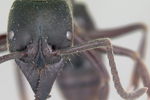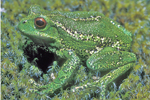New species discovered in threatened swamps
Scientists have identified a new species of frog on the Malay Peninsula. The newly named Hylarana centropeninsularis was discovered in a swamp and genetic analyses revealed that it is evolutionarily distinct from its stream-dwelling cousins.
After publishing the discovery in the online journal Herpetologica, Kin Onn Chan, a doctoral candidate at the University of Kansas, told mongabay.com that the frog was actually first found 10 years ago.
“An ex-student of my ex-advisor at the National University of Malaysia collected it in one of her pit-fall traps… After digging through historical records and literature, we found that it was not the first time that that particular ‘species’ had been found,” Chan said.

The new frog species, Hylarana centropeninsularis. Photo by Chan et al.
Yet this original breakthrough went unrecognized when the frog was misidentified due to striking similarities with another species (Hylarana siberu) living in Sumatra, which is also black with orange stripes and yellow spots. But when Chan’s team examined their own Malaysian specimen, they became suspicious about the distance between the two habitats.
“Despite these similarities, it actually strengthened our suspicion that it was a new species because based on the Unified Species Concept, we know that it was quite improbable for the Peninsular Malaysian populations to be sharing genes with populations from Sumatra,” he said.
Tissue samples were sent back to a lab at the University of Kansas for genetic analysis and the team’s suspicions were confirmed. They had indeed identified a new species, although they speculate that both frogs probably share a common ancestor because the Strait of Malacca, the stretch of ocean that separates the two species, was once a land bridge.
The researchers named their rediscovery centropeninsularis, referring to the frog’s home, the center of Peninsular Malaysia. According to Chan, this was part of an effort to raise awareness of the region’s natural significance.
“I wanted to bring attention to Peninsular Malaysia,” he said. “When it comes to biodiversity and conservation, a lot of attention has been given to Borneo, Indonesia and Indochina but Peninsular Malaysia has always been overlooked.”

A peat swamp in Malaysian Borneo. Photo by Rhett A. Butler.
Hylarana centropeninsularis has evolved to live in swamps, a tropical forest habitat characterized by waterlogged soil, which are home to many different species of animals. Chan and his team have spent years studying the biodiversity of swamps and suspect they may house many more new species awaiting scientific observation.
“Swamp/peat ecosystems are very unique and species that live there have adapted to a very specialized lifestyle,” Chan said. “Due to the insular nature of many swap/peat habitats, it would be hard for species to disperse away… hence limiting gene flow.”
Despite its bright colors,Hylarana centropeninsularis is not poisonous.
Citations:
- Kin Onn Chan, Rafe M. Brown, Kelvin K.P. Lim, Norhayati Ahmad and Lee Grismer. 2014. A New Species Of Frog (Amphiba: Anura: Ranidae) of the Hylarana Signata Complex from Peninsular Malaysia. Herpetologica, 70(2), 2014, 228–240
Related articles
Dancing frogs: scientists discover 14 new species in India (PHOTOS, VIDEO)

(05/16/2014) Scientists have discovered 14 new species of frogs in the mountainous tropical forests of India’s Western Ghats, all of which are described in a recent study published in the Ceylon Journal of Science. The new species are all from a single genus, and are collectively referred to as “dancing frogs” due to the unusual courtship behavior of the males.
Game of thorns: colorful, spiky tree frog discovered in Vietnam

(04/25/2014) Evening fog settled quickly on Mount Ngoc Linh, as the steady drone of cicadas and crickets took up their usual nighttime chorus. The night calm was broken by sudden crashing through the thick bamboo stands and excited voices. High in this isolated cloud forest in central Vietnam, researchers had come upon the first thorny tree frog known to science.
Amphibian pandemic may have hit Madagascar, hundreds of species at risk of infection

(04/11/2014) Madagascar is one of the world’s hotspots for amphibian diversity, home to so many frog species that many of them don’t even have names. But soon the island may also harbor a fungus causing drastic declines – even extinctions – of frogs around the world. Ironically, the wildlife trade that’s often blamed for helping spread the disease may also give scientists a chance to prevent it.
Several Amazonian tree frog species discovered, where only two existed before

(03/18/2014) We have always been intrigued by the Amazon rainforest with its abundant species richness and untraversed expanses. Despite our extended study of its wildlife, new species such as the olinguito (Bassaricyon neblina), a bear-like carnivore hiding out in the Ecuadorian rainforest, are being identified as recently as last year. In fact, the advent of efficient DNA sequencing and genomic analysis has revolutionized how we think about species diversity. Today, scientists can examine known diversity in a different way, revealing multiple ‘cryptic’ species that have evaded discovery by being mistakenly classified as a single species based on external appearance alone.
Frog creates chemical invisibility cloak to confuse aggressive ants

(03/14/2014) The African stink ant creates large underground colonies that are home to anywhere from hundreds to thousands of ants, and occasionally a frog or two. The West African rubber frog hides in the humid nests to survive the long dry season of southern and central Africa. However, the ant colonies are armed with highly aggressive ant militias that fight off intruders with powerful, venomous jaws. So how do these frogs escape attack?
Scientists uncover new species of Andean marsupial frog

(03/05/2014) The term marsupial frog sound like a hoax, but, believe it or not, it’s real. Recently, herpetologists welcomed a new species, known as Gastrotheca dysprosita and described in the journal Phyllomedusa. Unlike mammal marsupials, which typically carry their young in pouches on their torsos and are found primarily in Australia, the Gastrotheca genus of frogs, which contains 62 species, is found in the Andes region on South America and sport their pouches on their backs (also called a “dorsal brood pouch”).
287 amphibian and reptile species in Peruvian park sets world record (photos)

(01/28/2014) It’s official: Manu National Park in Peru has the highest diversity of reptiles and amphibians in the world. Surveys of the park, which extends from high Andean cloud forests down into the tropical rainforest of the Western Amazon, and its buffer zone turned up 155 amphibian and 132 reptile species, 16 more than the 271 species documented in Ecuador’s Yasuní National Park in 2010.
New frog species discovered on tallest mountain in Indochina

(01/22/2014) A team of Australian and Vietnamese researchers recently discovered a new species of frog in the high elevations of Vietnam’s Mount Fansipan, according to a new paper in Zootaxa. The amphibian was named Botsford’s leaf-litter frog (Leptolalax botsfordi) as a tribute to Christopher Botsford for his role in amphibian biodiversity research in Asia.